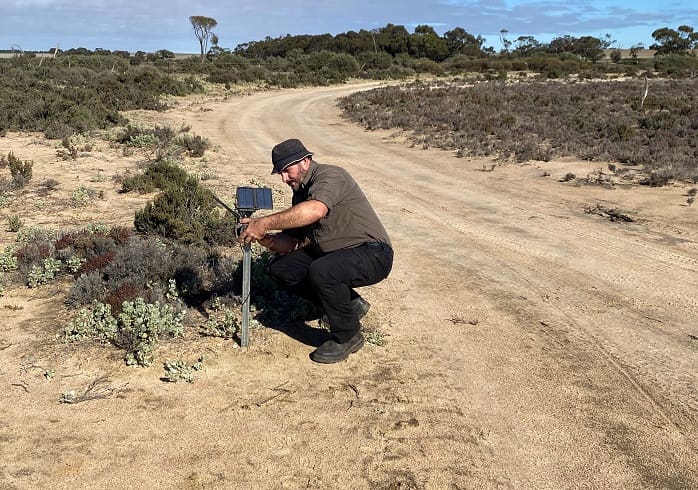
The project aimed to demonstrate the opportunities of using new technologies on-property to capitalise on existing community-based activities. Image – Midlands Biosecurity Group
REMOTE motion sensors, auditory controls, geographical mapping data and new technologies are among the wild dog management tools distributed to Western Australian sheep producers over the past three years.
Producers who attended the various training activities during the project have reported a reduction in the number of wild dogs, foxes, and pigs in the landscape.
The training and advisory services and equipment has been made possible by a $270,000 investment by Australia Wool Innovation.
The collaborative funding of wild dog and vertebrate pest animal control activities under the WA Wild Dog Action Plan, has a goal of increasing the kilograms of wool produced, landholder participation rates in vertebrate pest control, the mental well-being of wool growers and native wildlife.
The programs administered by the Department of Primary Industries and Regional Development, Western Australia and the WA Wild Dog and Vertebrate Pest Training Project have resulted in 28 training activities across seven Recognised Biosecurity Groups the regions, attended by more than 317 sheep producers and pastoralists.
More than 100 training resource tool kits were distributed along with remote motion sensors, auditory controls, geographical mapping data, and a range of new technologies.
The new technology included eVorta® software images for quick identification and notification of target species, thermal and infra-red technology, canid pest ejectors bait head trials, 3G remote monitoring cameras, feral pig trapping systems, satellite wild dog trap technology and Ezy2C® units.
All were offered and demonstrated to sheep and wool producers to enhance their knowledge and skills in the control of wild dogs, pigs and foxes.
Practical activities were supported by the development of a series of locally based community engagement videos and podcasts and engagement opportunities at numerous industry field days and events.
DPIRD invasive species sustainability and biosecurity project coordinator, Kim Haywood, said new technologies such as the Ezy2C® GPS satellite foot hold trap alert and monitoring system attracted interest from pastoralists, sheep producers and associated service providers.
“The project provided an ideal opportunity to bring people together to learn about effective control technologies and be trained in its use, then upskill participants in other areas of capacity related to wild dog management at the same time.
“It is also encouraging people in the industry to think creatively and laterally about ways to manage wild dogs, rather than just relying on the traditional ways that have been used for many years,” she said.
The project, which concluded in December 2022, provided land managers with the opportunity to use the latest control tools such as 4G cameras, CPEs, Hoggone and Matlock feral pig traps.
Ms Haywood said the project delivered great resource materials for producers and pastoralists that are relatable and topical for coordinated pest control.
She said sheep and wool producers were more likely to participate in programs when they see their own neighbours having success in baiting and trapping efforts.
“The success of the project has resulted in increased demand from producers to access baiting products and technologies,” Ms Haywood said.
“The RBGs are keen to ensure new technologies can be shared with sheep and wool producers across the state to safeguard the longevity of the Australian wool industry.
“The outcomes of this project will ultimately enable the return of sheep to the regions.”
AWI program manager vertebrate pests Ian Evans said the project aimed to increase the uptake of traditional control tools by individual producers and demonstrate the opportunities of using new technologies on-property to capitalise on existing community-based activities.
“The focus of the training activities was conducted mainly in the frontline regions where the bulk of the WA sheep flock faces the main threat from wild dogs.
“It has contributed to increasing the knowledge and skills in the control of wild dogs and other vertebrate pests and lifted producer participation in wild dog and vertebrate predator pest control in WA.”
The participating RBGs were Carnarvon, Meekatharra, Goldfields Nullarbor, Northern, Midlands, Central Wheatbelt and Southern.
Source – AWI.

HAVE YOUR SAY